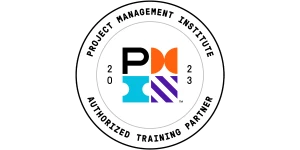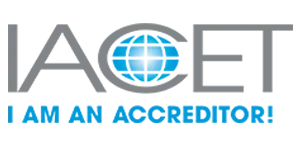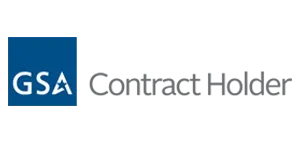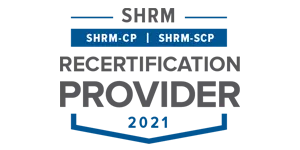The Guide to Agile SDLC: A Modern Approach to Software Development
To meet the growing market demands and keep up the pace, most of the software development teams are transitioning towards Agile SDLC from traditional approach.
With 70% organizations are now adopting the Agile methodologies, the software industries has seen the changes in the recent years.
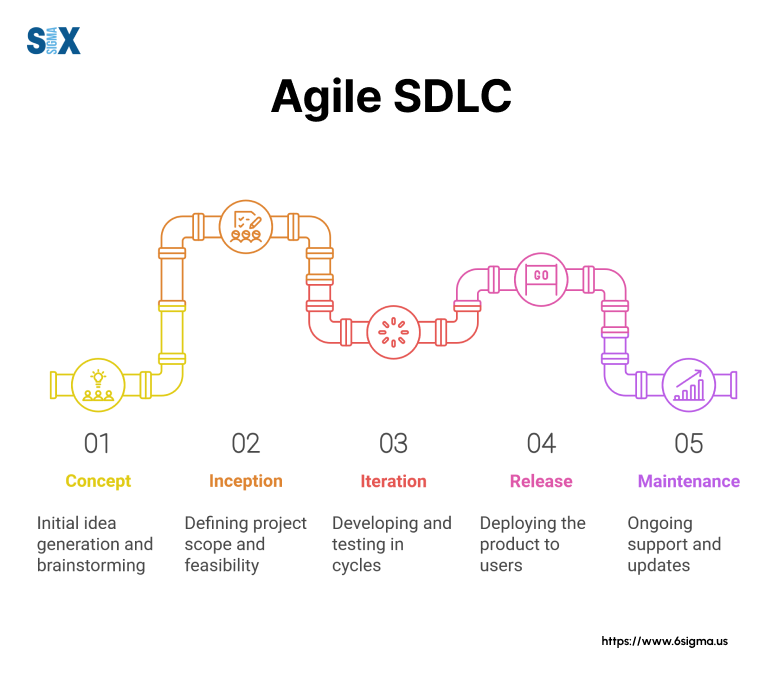
Key Highlights
- Building Successful Agile Teams
- Mastering Agile Development Phases
- Implementing Effective Agile Practices
- Measuring Development Success Metrics
- Scaling Agile Across Organizations
What Is Agile SDLC?
Agile SDLC represents a dynamic approach to software development that prioritizes flexibility, collaboration, and customer satisfaction.
This methodology breaks down projects into small, manageable chunks called iterations, allowing teams to adapt quickly to changing requirements while maintaining steady progress.
Core Principles of Agile Methodology
The foundation of Agile SDLC rests on four key values outlined in the Agile Manifesto.
These values emphasize individuals and interactions over processes and tools, working software over documentation, customer collaboration over contract negotiation, and responding to change over following a plan.
Teams following Agile SDLC work in short cycles, typically lasting two to four weeks.
During each cycle, they plan, develop, test, and deliver functional pieces of software.
This iterative approach ensures regular feedback and allows for quick adjustments based on user needs and market demands.
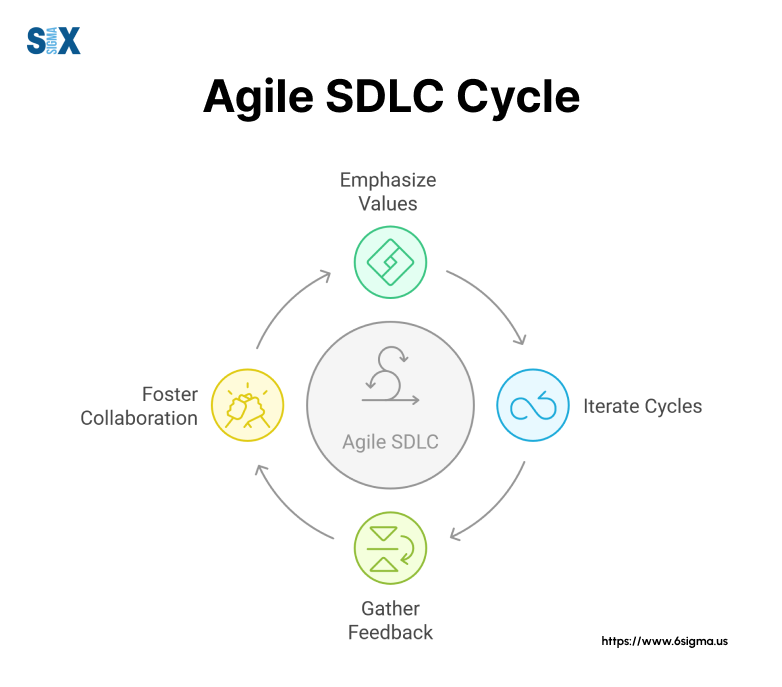
Key Differences From Traditional SDLC
Traditional SDLC follows a sequential waterfall model where each phase must complete before moving to the next.
In contrast, Agile SDLC operates through parallel activities and continuous iteration.
While traditional methods require extensive upfront planning, Agile teams plan incrementally, adapting their approach based on real-time feedback and results.
Benefits and Challenges of Agile SDLC
Organizations implementing Agile SDLC often experience faster time-to-market, improved product quality, and higher customer satisfaction.
Teams can respond quickly to market changes and user feedback, reducing the risk of developing obsolete features.
However, Agile SDLC also presents certain challenges.
Some organizations struggle with:
- Managing changing requirements and scope
- Maintaining consistent communication across distributed teams
- Balancing technical debt with rapid development
- Securing stakeholder buy-in for iterative delivery
The success of Agile SDLC depends heavily on team collaboration and communication.
Daily stand-up meetings, sprint planning sessions, and regular retrospectives help teams stay aligned and focused on project goals.
These practices ensure transparency and enable quick problem-solving when issues arise.
Remote work environments have added new dimensions to Agile SDLC implementation. Teams now use virtual collaboration tools and modified ceremonies to maintain agile practices while working distributed.
This adaptation has led to innovative approaches in managing projects and maintaining team cohesion.
Security considerations in Agile SDLC have evolved to meet modern threats. Teams now integrate security practices throughout the development cycle rather than treating it as a separate phase.
This “shift-left” approach to security helps identify and address vulnerabilities earlier in the development process.
The integration of DevOps practices with Agile SDLC has created more efficient software delivery pipelines.
As organizations scale their Agile practices, frameworks like SAFe (Scaled Agile Framework) and LeSS (Large-Scale Scrum) provide structured approaches for managing multiple teams and complex projects while maintaining agile principles.
Master the fundamentals of change leadership and overcome implementation challenges with Lean Six Sigma Organizational Deployment
The Phases of Agile SDLC
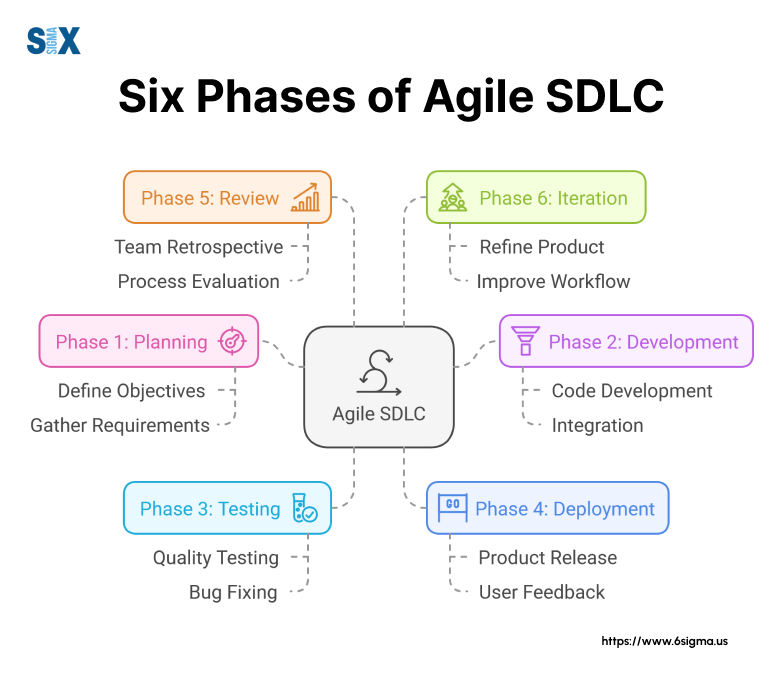
The Agile SDLC consists of six distinct phases that work together to create a flexible and efficient development process.
Each phase builds upon the previous one while maintaining the ability to adapt to changes and new requirements.
Concept and Ideation Phase
The concept phase marks the beginning of the Agile SDLC journey. Project stakeholders and development teams gather to define the project scope, identify key requirements, and establish initial priorities.
During this phase, teams create user stories, develop rough estimates, and determine the project’s feasibility.
Teams typically spend 1-2 weeks in the concept phase, focusing on:
- Market research and user needs analysis
- Initial resource planning
- High-level technical requirements
- Preliminary risk assessment
Inception Phase
During inception, teams lay the groundwork for successful project execution. This phase involves setting up the development environment, forming the core team, and creating initial architectural designs.
Teams also establish their working agreements and define their definition of “done.”
Key activities in this 2-3 week phase include establishing:
- Development infrastructure
- Team roles and responsibilities
- Sprint duration and ceremony schedules
- Initial product backlog
Iteration and Construction Phase
The iteration phase forms the heart of Agile SDLC. Teams work in short sprints, typically 2-4 weeks long, to build and test working software incrementally.
Each iteration includes planning, development, testing, and review activities.
During each iteration, teams:
- Select items from the product backlog
- Design and develop features
- Conduct testing and quality assurance
- Demo completed work to stakeholders
Release Phase
The release phase prepares the software for production deployment. Teams focus on final testing, documentation, and user training.
This phase might span several iterations, depending on the project’s complexity and release requirements.
Release activities include:
- System integration testing
- User acceptance testing
- Performance optimization
- Release documentation preparation
Production Phase
Once the software moves into production, teams monitor its performance and provide ongoing support.
This phase focuses on maintaining system stability while gathering user feedback for future improvements. Teams also handle any immediate issues or bugs that arise post-deployment.
Production phase responsibilities include:
- System monitoring and maintenance
- Bug fixes and patches
- User support
- Performance tracking
Retirement Phase
The retirement phase occurs when a software version reaches its end of life. Teams plan and execute the transition to newer versions or replacement systems.
This phase requires careful planning to minimize disruption to users and business operations.
Key retirement activities include:
- Data migration planning
- User transition strategies
- System decommissioning procedures
- Legacy system documentation
Throughout these phases, teams maintain flexibility to adapt to changing requirements and new information.
The Agile SDLC phases don’t follow a strict sequential order like traditional methodologies. Instead, they often overlap and iterate based on project needs and feedback.
Modern Agile teams often integrate DevOps practices across these phases, automating processes where possible to increase efficiency and reliability.
This integration helps teams maintain consistent quality while moving quickly through development cycles.
Agile Methodologies in SDLC
Different Agile methodologies offer unique approaches to software development, each with specific practices and principles.
Organizations often select a methodology based on their project requirements, team size, and business goals.
Scrum Methodology
Scrum stands as the most widely adopted Agile methodology, used by 66% of development teams worldwide.
This framework divides work into fixed-length sprints, typically lasting two to four weeks. Teams work from a prioritized product backlog, selecting items to complete during each sprint.
The Scrum framework relies on three key roles:
- Product Owner – Manages the product backlog and priorities
- Scrum Master – Facilitates the process and removes obstacles
- Development Team – Creates and delivers the product increments
Daily stand-up meetings, sprint planning sessions, and retrospectives form the backbone of Scrum’s communication structure.
These ceremonies help teams stay aligned and address challenges quickly.
Kanban System in Agile SDLC
Kanban focuses on visualizing work and limiting work in progress (WIP) to optimize flow and reduce bottlenecks.
Unlike Scrum’s fixed sprints, Kanban operates on a continuous flow model where teams pull work as capacity becomes available.
The Kanban board serves as the primary tool, displaying:
- Work items in different stages
- WIP limits for each column
- Blocked items and dependencies
- Cycle time measurements
Teams using Kanban track metrics like lead time and cycle time to improve their process efficiency. This data-driven approach helps identify and eliminate workflow bottlenecks.
Extreme Programming (XP)
XP emphasizes technical excellence through practices like pair programming, test-driven development (TDD), and continuous integration.
This methodology works particularly well for projects with changing requirements and need for high-quality code.
Key XP practices include:
- Regular code refactoring
- Small, frequent releases
- Continuous feedback
- Simple design principles
XP teams often work in weekly cycles, combining planning, development, and testing activities.
The close collaboration between developers and stakeholders ensures rapid feedback and quick adaptation to changes.
Lean Software Development with Agile SDLC
Lean principles, adapted from manufacturing, focus on eliminating waste and optimizing the entire value stream.
This methodology emphasizes delivering value to customers while minimizing unnecessary work.
The seven principles of Lean development guide teams to:
- Eliminate waste
- Build quality in
- Create knowledge
- Defer commitment
- Deliver fast
- Respect people
- Optimize the whole
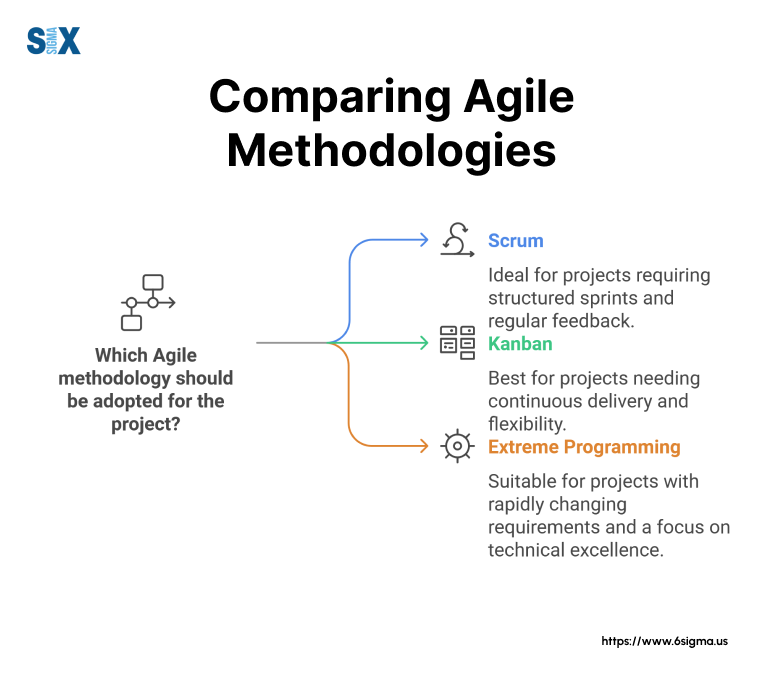
Modern teams often blend elements from multiple methodologies to create hybrid approaches that suit their specific needs.
For example, combining Scrum’s structured sprints with Kanban’s visual management can provide both flexibility and predictability.
The integration of DevOps practices has influenced how teams implement these methodologies. Automated testing, continuous integration, and deployment pipelines support faster delivery while maintaining quality standards.
Remote work has prompted adaptations in how teams practice these methodologies. Virtual boards, online ceremonies, and digital collaboration tools now facilitate Agile practices across distributed teams.
Security considerations get woven into each methodology through practices like security testing in XP, security-focused user stories in Scrum, or security checkpoints in Kanban workflows.
The choice of methodology should align with team capabilities, project requirements, and organizational culture.
Implementing Agile SDLC
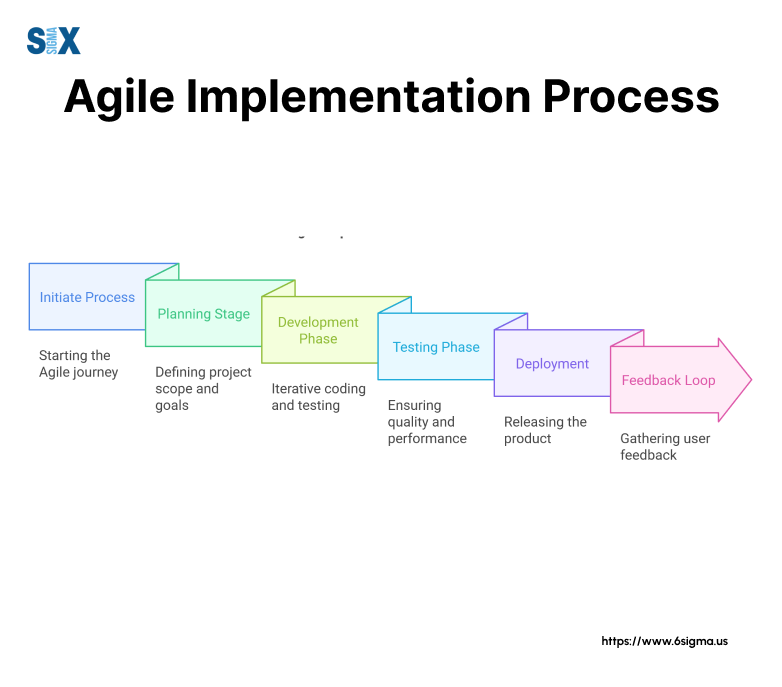
Successfully implementing Agile SDLC requires careful planning, the right team structure, and appropriate tools.
Organizations must create an environment that supports agile practices while addressing potential roadblocks.
Team Roles and Responsibilities
The success of Agile SDLC depends heavily on clear role definition and accountability.
Each team member plays a specific part in the development process:
Product Owner serves as the customer advocate, managing the product backlog and setting priorities. They make critical decisions about features and ensure the team delivers maximum value.
Scrum Master or Agile Coach guides the team through the agile process, removing obstacles and facilitating communication.
They protect the team from external disruptions and help maintain focus on sprint goals.
Development Team members bring diverse skills to handle design, coding, testing, and deployment. Cross-functional capabilities allow teams to deliver complete features without external dependencies.
Stakeholders provide feedback and direction throughout the development cycle. Regular involvement ensures the product meets business objectives and user needs.
Learn effective brainstorming and collaboration techniques for achieving project goals.
Tools and Technologies
Modern Agile teams rely on various tools to manage their work effectively:
Project Management Tools:
- JIRA for issue tracking and sprint management
- Trello for visual task management
- Azure DevOps for end-to-end project visibility
- Monday.com for team collaboration
Development and Testing Tools:
- Git for version control
- Jenkins for continuous integration
- Selenium for automated testing
- Docker for containerization
Communication platforms like Slack and Microsoft Teams facilitate real-time collaboration, especially crucial for remote teams.
Best Practices for Adoption of Agile SDLC
Starting small and scaling gradually proves more successful than attempting full organizational transformation immediately.
Begin with a pilot project and experienced team members who can guide others through the transition.
Regular training sessions help teams understand agile principles and practices.
Workshops on specific techniques like user story writing or estimation build practical skills needed for successful implementation.
Creating a dedicated space for agile teams fosters collaboration and communication. Even in remote settings, virtual team rooms can provide similar benefits through digital tools and regular interaction.
Documentation should remain light but sufficient. Focus on essential information that adds value to the development process rather than creating extensive documentation for its own sake.
Common Challenges and Solutions
Resistance to change often emerges as the primary challenge.
Address this through:
- Clear communication of benefits
- Early wins demonstration
- Regular feedback collection
- Continuous improvement focus
Maintaining consistency across distributed teams requires:
- Standardized processes
- Regular synchronization meetings
- Shared documentation practices
- Clear communication channels
Technical debt management becomes crucial as teams move quickly.
Solutions include:
- Regular refactoring sessions
- Technical debt tracking
- Quality metrics monitoring
- Balance between speed and sustainability
Stakeholder alignment often proves challenging.
Overcome this through:
- Regular demos and updates
- Clear success metrics
- Transparent progress tracking
- Continuous feedback loops
Integration with existing processes requires careful planning.
Consider:
- Gradual process modification
- Hybrid approaches where needed
- Clear transition timelines
- Regular evaluation points
Security integration throughout the development cycle demands:
- Automated security testing
- Regular security reviews
- Compliance checkpoints
- Security-aware design practices
As organizations scale their Agile implementation, they should:
- Establish communities of practice
- Create shared guidelines
- Maintain consistent tooling
- Foster knowledge sharing
Remote work adaptation requires:
- Virtual collaboration tools
- Modified ceremonies
- Clear communication protocols
- Regular check-ins
The implementation journey varies for each organization, but success depends on commitment, flexibility, and continuous improvement.
Measuring Success in Agile SDLC
Measuring success in Agile SDLC requires a balanced approach that considers both quantitative metrics and qualitative feedback.
Organizations need clear indicators to track progress, identify areas for improvement, and demonstrate value to stakeholders.
Key Performance Indicators (KPIs)
Effective KPIs provide insights into the health and performance of Agile projects. These metrics should align with business objectives while supporting continuous improvement.
Sprint Burndown charts track the completion of work during each sprint. Teams use these charts to monitor progress and identify potential delays early in the development cycle.
Velocity measures the amount of work completed in each sprint. This metric helps teams improve their estimation accuracy and plan future sprints more effectively.
Code Quality metrics include:
- Test coverage percentage
- Number of defects found
- Technical debt measurements
- Code complexity scores
Release Burnup charts show progress toward release goals, helping stakeholders understand when features will be ready for deployment.
Metrics for Team Productivity
Team productivity measurements focus on flow efficiency and delivery speed. These metrics help identify bottlenecks and optimize processes.
Lead Time tracks how long it takes for work to move from idea to implementation. Shorter lead times indicate more efficient processes and better team performance.
Cycle Time measures the duration between starting and completing work items. Teams use this metric to identify and eliminate process bottlenecks.
Customer Satisfaction Measures of Agile SDLC
Net Promoter Score (NPS) provides insights into customer satisfaction and loyalty. Regular surveys help teams understand how well their products meet user needs.
User Story Completion Rate shows how effectively teams deliver planned functionality. This metric helps ensure that development efforts align with customer expectations.
Feature Usage Analytics reveal how customers interact with delivered features. Teams use this data to guide future development priorities and improve existing functionality.
Customer Feedback Metrics include:
- Support ticket volumes
- Feature request patterns
- User engagement rates
- Customer retention data
ROI Calculation for Agile SDLC
Return on Investment calculations help justify Agile adoption and continued investment in process improvement. Organizations track both financial and non-financial benefits.
Cost Savings come from:
- Reduced development waste
- Faster time to market
- Lower defect rates
- Improved resource utilization
Business Value Delivered measures the actual impact of new features and improvements on business outcomes.
Teams track metrics like:
- Revenue generation
- Cost reduction
- Market share growth
- Customer acquisition
Risk Reduction Benefits include:
- Earlier problem detection
- Improved project predictability
- Better alignment with market needs
- Enhanced quality outcomes
Modern Agile teams also measure:
- DevOps integration success
- Security compliance rates
- Remote collaboration effectiveness
- Innovation metrics
Teams should avoid metric overload by focusing on measurements that drive meaningful improvements. Regular review and adjustment of metrics ensure they remain relevant to current business goals.
Data collection automation through integrated tools helps teams gather metrics without disrupting their work.
This automation enables real-time monitoring and faster decision-making.
Success measurements should evolve as teams mature and business needs change.
Regular retrospectives provide opportunities to evaluate and adjust tracking methods.
Organizations scaling Agile practices need additional metrics to monitor:
- Cross-team coordination
- Program-level progress
- Enterprise alignment
- Organizational agility
The key to successful measurement lies in balancing quantitative data with qualitative insights. This balanced approach provides a more complete picture of project and team health.
Learn to create effective project charters and measure development success with Define Phase and Project Selection
Moving Forward with Agile SDLC
The evolution of software development continues to validate the principles and practices of Agile SDLC.
Organizations worldwide have witnessed significant improvements in project success rates, team productivity, and customer satisfaction through Agile adoption.
Key Takeaways From Agile Implementation
Successful Agile SDLC implementation requires more than just following prescribed practices. Teams must embrace the mindset of continuous improvement and adaptation.
The six phases of Agile SDLC provide a framework that supports both structure and flexibility, enabling teams to deliver value consistently while remaining responsive to change.
The various Agile methodologies offer different approaches to meet specific organizational needs.
Whether through Scrum’s structured sprints, Kanban’s flow-based system, or XP’s technical practices, teams can choose and adapt methods that best suit their context.
The Future of Agile SDLC
The software development landscape continues to evolve, bringing new opportunities and challenges for Agile teams.
Artificial intelligence and machine learning are transforming how teams estimate work, detect defects, and optimize processes.
These technologies promise to enhance decision-making and automate routine tasks, allowing teams to focus on higher-value activities.
Taking Action on Agile Adoption
Organizations considering Agile SDLC adoption should start with clear objectives and realistic expectations. Begin by:
- Assessing current development practices
- Identifying improvement opportunities
- Training teams in Agile principles
- Selecting appropriate tools and methodologies
Success requires commitment from leadership and team members alike. Regular evaluation and adjustment of practices ensure continued improvement and alignment with business goals.
The journey toward Agile maturity never truly ends.
Each organization must find its path, guided by Agile principles but adapted to its unique context and needs.
The rewards of successful Agile adoption – faster delivery, higher quality, and improved customer satisfaction – make the effort worthwhile.
SixSigma.us offers both Live Virtual classes as well as Online Self-Paced training. Most option includes access to the same great Master Black Belt instructors that teach our World Class in-person sessions. Sign-up today!
Virtual Classroom Training Programs Self-Paced Online Training Programs

